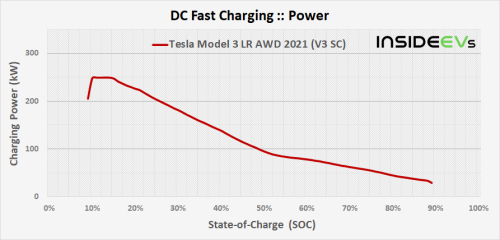Welcome to another Tesla Tuesday!
We are back from a 2500-mile road trip with our Model Y. I was collecting data from the whole trip, and I have a couple more posts coming to detail the experience, but while I work on that, I want to start by devoting an entire post to explaining the charging curve of a Tesla.
The key point here is that when you are supercharging, the speed of your charging depends on how full your battery is. The battery can be charged much faster from 10% to 30% than from 70%-90%.
The above chart shows the curve for a 250kW charger. Most superchargers are 150kW max output, but newer ones are 250kW. (A few of them are 70kW but those are rare.) For a 150kW charger, imagine the same curve but it is capped at 150kW. So it’s slower at first, but by the time you hit ~40% charge, the two chargers give you the same speed (…usually. More on this later.)
Imagine you could fill your gas tank faster the emptier it was. You’d only want to put in as much gas as you needed to get to your next fueling stop. So whichever speed you’re using to charge, the key takeaway is that if you’re trying to spend the least amount of time possible at a charger, you want to start at around 10-15% and charge as little as you need to get to the next charger.
This becomes important if you’re trying to optimize the charging stops on a long road trip. There’s a tradeoff between getting enough juice to skip over a charging stop and the slower charging speeds you that give you that extra juice. Thankfully, you don’t have to think about this as most EV trip planners (including the one built into Teslas) take this into account automatically.
Here’s a chart from all the supercharges we’ve done on our Model Y:
Click to open that in a new tab. You should see three basic curves. The top one is 250kW chargers, the second one is 150kW chargers, and the bottom one is from one use of a 70kW charger, but mostly it’s from lower output at a 150kW charger. This is because the older 150kW superchargers are paired. When you pull up to a charger, the stalls are labeled 1A, 1B, 2A, 2B, etc. If you are sharing an A/B with another car, you split the 150kW. As a supercharger gets busier, this means it takes longer to charge causing longer waits to for people to get a stall. Obviously this isn’t ideal so the newer 250kW chargers are all isolated. No matter how busy the charger is, you’ll get the full firehose of electrons shooting into your car.
If this sounds complicated, I assure you that you can happily drive an EV without knowing any of this. In fact, it’s obvious that a lot of Tesla owners are clueless to the differences between chargers and the pairing of the 150kW chargers. I love this stuff and I want to be as efficient as possible so I geek out with all this data. And if you think this was geeky, wait until I detail how I planned our trip in a future post!


